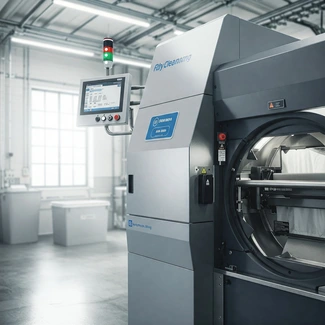
🌱 Innovations in Dry Cleaning Machinery: Sustainable, Energy-Efficient, and Smart Solutions
The dry cleaning machinery industry is evolving rapidly with innovations that focus on sustainability, energy efficiency, and automation. Businesses in the industry are embracing new technologies that reduce environmental impact while improving operational efficiency and cleaning performance.
🌿 1. Shift Toward Eco-Friendly Solvents
Carbon Dioxide (CO₂) Machines
CO₂-based dry cleaning machines are gaining popularity as a safer, more environmentally friendly alternative to traditional solvents like perchloroethylene (PCE). These machines use liquid CO₂ to clean clothes, reducing the environmental impact and offering a more sustainable option. While the initial investment can be high, the operational costs are lower due to the reuse of CO₂, making it an attractive option for businesses looking to reduce their carbon footprint.
Silicone-Based Solvents
Machines using GreenEarth silicone-based solvents are becoming more widely adopted due to their non-toxic nature and environmental benefits. These solvents are biodegradable, non-hazardous, and gentler on fabrics, offering a safer cleaning process for both workers and customers.
⚡ 2. Energy-Efficient Machines
Low-Energy Dryers
Modern dry cleaning machinery is designed with energy efficiency in mind. These machines often incorporate advanced drying technologies such as heat recovery systems, which reduce the amount of energy required for drying clothes.
Automated Systems
The integration of automation into machinery is helping to reduce energy consumption. Automated systems can detect fabric types and adjust settings accordingly, reducing unnecessary energy use and ensuring optimal cleaning for each load.
📱 3. Advanced Monitoring and Control Systems
IoT Integration
Many newer dry cleaning machines come equipped with Internet of Things (IoT) technology. This allows businesses to remotely monitor machines, track usage, and even perform diagnostics. IoT-enabled systems can help prevent malfunctions and improve machine lifespan by ensuring they operate within optimal parameters.
Smart Control
Machines are increasingly equipped with smart controls that allow for precise management of solvents, temperatures, and drying times. This level of control leads to higher-quality cleaning results and more consistent performance.
💧 4. Chemical-Free Cleaning Solutions
Water-Based Dry Cleaning
Water-based machines, often referred to as wet cleaning machines, are becoming increasingly popular due to their ability to clean delicate fabrics without the use of harmful chemicals. These machines use water and biodegradable detergents combined with gentle agitation and low heat to clean garments.
Superheated Steam Technology
Some machines utilize superheated steam for cleaning and sterilizing garments. This method offers a chemical-free alternative, reducing the need for solvents while maintaining high levels of cleanliness and fabric care.
🏙️ 5. Compact, User-Friendly Designs
Space-Saving Models
In busy urban environments, space can be a premium. Compact, smaller dry cleaning machines are gaining traction as they offer high performance in smaller footprints. These machines allow dry cleaners to operate in locations where traditional equipment would not fit.
User-Friendly Interfaces
Modern machines often feature intuitive touchscreens and easy-to-navigate control panels, making them more accessible to operators, even those without extensive technical training.
♻️ 6. Recycling and Waste Management Features
Solvent Recycling Systems
To reduce waste and solvent consumption, some dry cleaning machines come with built-in recycling systems that filter and reuse solvents. This not only reduces operating costs but also minimizes environmental impact.
Water Recycling
Similar to solvent recycling, many modern machines are designed to recycle water used in the cleaning process, ensuring minimal water waste. These systems are becoming more common, particularly in areas with water scarcity concerns.
📊 7. Market Trends in Dry Cleaning Machinery
Shift to Franchise Models
As more dry cleaning businesses adopt eco-friendly practices and look to automate their operations, many are turning to franchises to expand and leverage shared equipment and technology. Franchises also benefit from economies of scale when investing in high-end machinery.
Maintenance and Service Contracts
With the increasing complexity of dry cleaning machines, manufacturers are offering more comprehensive service contracts, ensuring that businesses can minimize downtime and extend the life of their machinery.
🏭 8. Key Manufacturers of Dry-Cleaning Machinery
- Electrolux Professional: Known for their advanced washing and drying solutions, Electrolux offers energy-efficient and eco-friendly dry cleaning machinery.
- Fagor Industrial: Fagor’s dry-cleaning machines are widely used in commercial and industrial settings. Their models are known for durability and efficiency.
- Union Dry Cleaning: They focus on eco-friendly dry cleaning systems, including CO₂ machines, and offer high-tech automation and recycling systems.
- Ginsana: Specializing in environmentally-friendly dry-cleaning machinery, Ginsana offers innovative machines that use both water and solvent-based cleaning systems.
🔮 9. The Future of Dry Cleaning Machinery
Fully Automated Facilities
The future of dry cleaning may include fully automated facilities where machines operate with minimal human intervention. This could reduce labor costs and improve overall operational efficiency.
Greener Solvents and Methods
Research into even more sustainable cleaning methods, such as plant-based solvents or further advancements in CO₂ cleaning technology, is ongoing.
🏁 Conclusion
The dry cleaning machinery sector is evolving rapidly with a strong emphasis on sustainability, energy efficiency, and automation. Businesses that invest in these advanced technologies can reduce their environmental footprint, improve cleaning quality, and ultimately achieve long-term cost savings.
Secure Kiosk Mode
Lock your device to DryLaun, block unwanted apps, and keep your staff focused while managing your store with a secure, distraction-free laundry billing management system.
Learn More →

